|
By CDR.
Robert S. Pandis
“Panda” June 2005
Introduction
Note: I first
published a version of this article in 2002 with very
different conclusions. This article's conclusions super
cede all previous articles. Live and learn.
Collecting Imperial aviation badges, from any country,
requires careful research and some baseline reference
material. There are plenty of excellent reference books
on the market dealing with the award criteria and
history of these badges, but few that focus on the
design details of period badges.
What is meant by the term “period badge”? For this
discussion, the criteria is based on the time of
production from 1913, when the Prussian Army Pilot badge
was first authorized, until the end of WWII, when
legitimate production ended and most firms went out of
business.
The real purpose of this article is to establish a
baseline for the prominent badge manufacturers. In
addition, collectors can then include their own criteria
for evaluation. The study of silver marks will play
heavily into this effort because, as we will see in most
cases, the improper application of these marks or design
flaws by a forger will help reveal them as fakes.
CDR. Robert Pandis
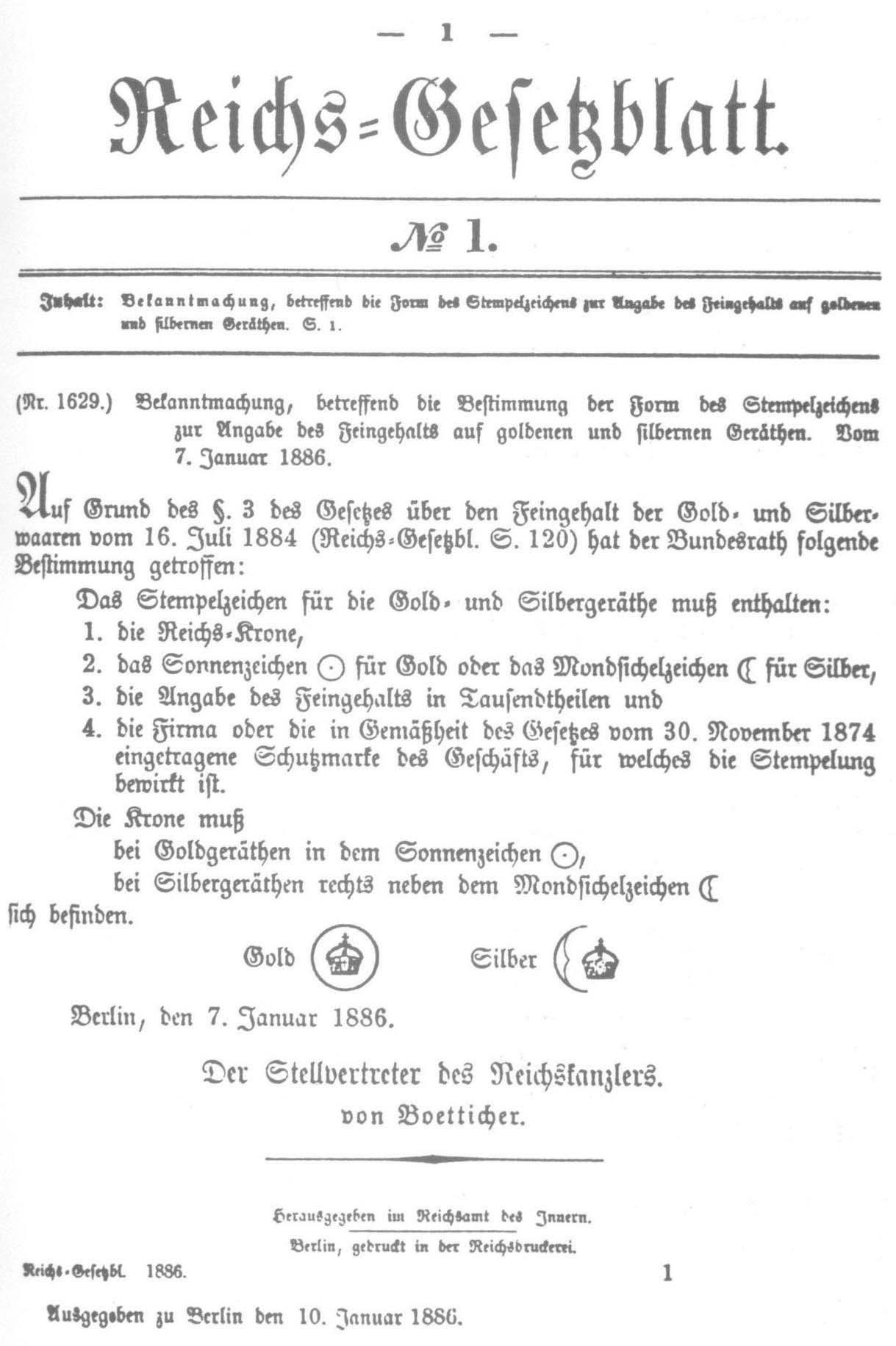
On January 7,
1886, a law was enacted, based on an Imperial Order
dated July 16, 1884, by the Deputy of the Federal
Chancellor von Boetticher. The law stated that hallmarks
for gold and silver
articles were required to contain the following:
1. The Imperial Crown
2. The Sun sign for gold and the Crescent Moon sign for
silver
3. The declaration of precious metal content in parts
per thousand
4. All firms with registered trademarks had, by law,
from November 1874 to show these signs (as stated
above.)
Further, the Imperial Crown for gold must appear inside
the sun and, for silver, appear to the right of the
Crescent Moon. An exception in Paragraph 9 of the Order
is made for jewelry and small wares; which were not
required to be marked.
Given the 1886 Prussian Imperial Order, a question
commonly asked by many collectors is “Why do some German
Imperial era badges have only the Crescent/Sickle Moon,
and 800 content marks; while others have the Crescent
Moon, Imperial Crown, and 800 marks required by the
Imperial Order.
To start,
this law only applied to Prussian firms so you will not
find these marks from firms located in other German
States, most commonly those who manufactured Bavarian
badges such as Carl Poellath, who will be covered in
this article. A close look at silver content is
warranted since one key inspection point when evaluating
the authenticity of a badge is the silver content vs.
its silver hallmarks. If a badge is marked as 800 parts
silver or greater, and it is plated, this badge can
immediately be ruled out as a forgery.
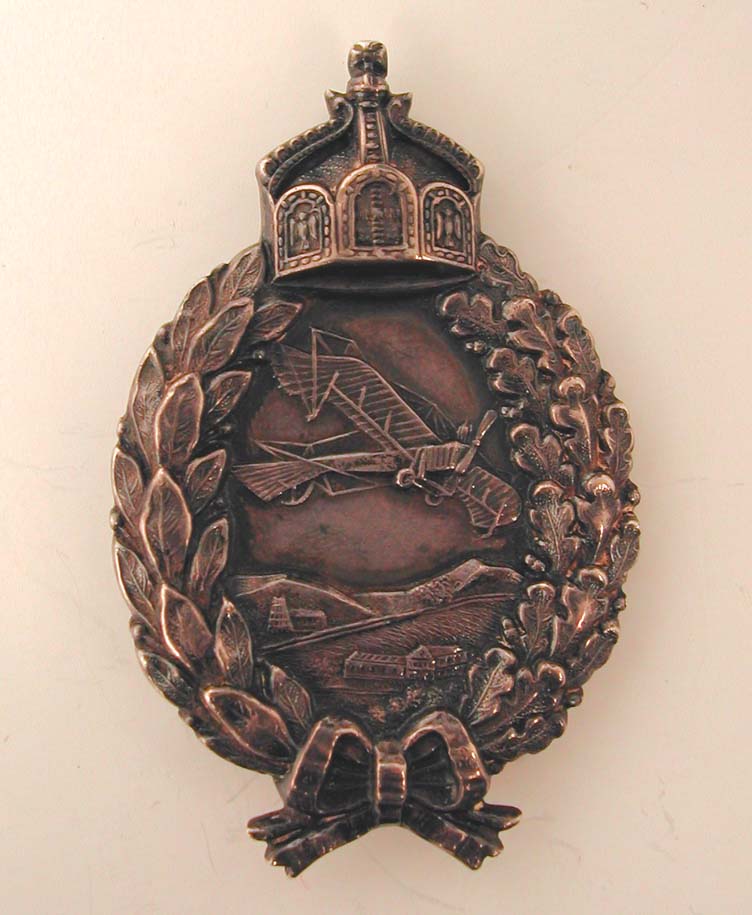
Period Prussian Pilot’s
Badge. Crown inserts are cutout. Length - 72 mm, Width -
46 mm, weight - 29.58g. Standard Juncker crescent moon
and 800 silver marks on the reverse.
“Panda’s Juncker Gouge:”
Badges should
really contain the percentage of silver indicated by
their hallmarks. If marked 800 then it should not be
plated. A Juncker’s pilot badge in 800 silver weights in
the range of 29.0 - 30.5 g depending on crown insert
cutouts, finishing, wear etc. 30.4 grams equals ~ 5
quarters and 1 dime in change for a field expedient
check. The point here is that they are heavier than the
plated fakes.
Details should conform to known period baseline
examples. Size dimensions should be very close. I prefer
cutout crown inserts but will consider the whole badge
if they are not.
The Juncker cross is typically square and not stylized,
but variations are accepted.
Reverse of crown where pin attaches should be deep and
cupcake shaped. I do not accept shallow or poorly formed
crown well areas.
Hinge should be Juncker T-pin style, however period
repairs are common. Solder areas should be aged with
patina. New solder is hard to patina, be cautious of
chemically applied false patinas. Edges between soldered
pieces should be skillfully done and without gaps etc.
In my research, no C.E.Juncker badge using both Imperial
Crown and Crescent Moon hallmarks was found that met the
baseline design criteria. But the real message here is
that hallmarks can be changed very quickly, so the
entire badge must be considered.
If a certain firm marks a badge, it should have design
characteristics of that firm. With Juncker you should
start with the proper crown well and then work from
there.
Unmarked badges are accepted, but must still meet the
design criteria of the firm that produced it.
Remember that die-stamped badge details do not vary. All
period Juncker marked badges should have the accepted
Juncker design features, and counter arguments are
without merit.
Period Prussian Pilot Badges. Photo
Credit Neal O’Conner
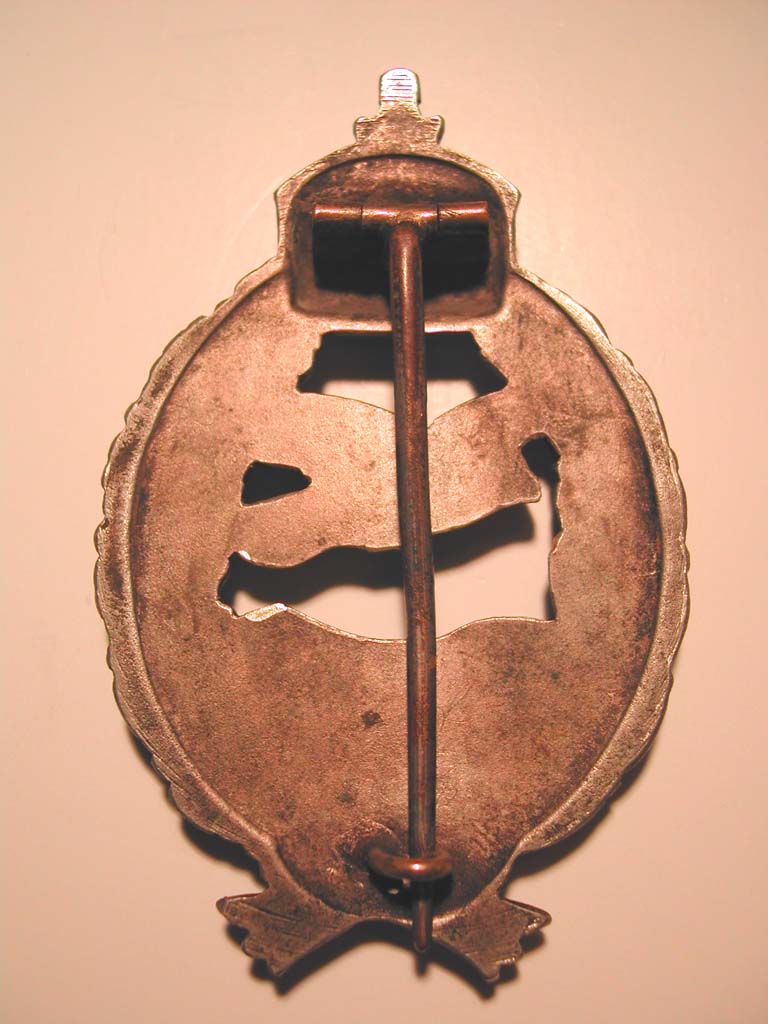
Unmarked period
Commemorative Prussian Pilot Badge of the Juncker
design. These original badges were made by Junckers and
sold to distributors. Note the crown well. ~ Length - 72
mm, Width - 44 mm, Weight 24.58g.
Fake Juncker Badges
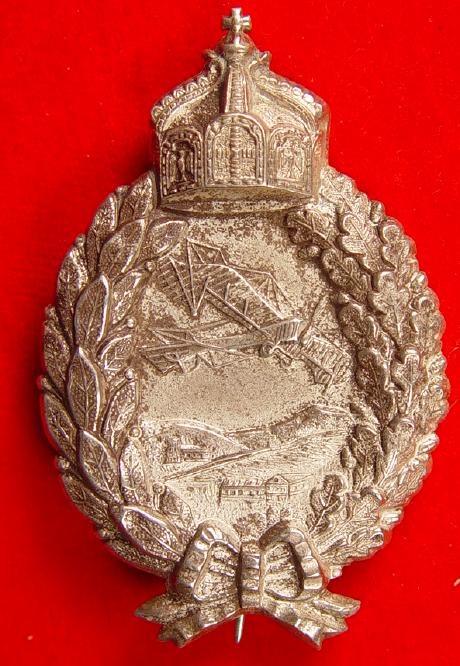
Crown inserts are not
cutout. Cross is stylized vs. chunky Juncker style.
Details are lacking
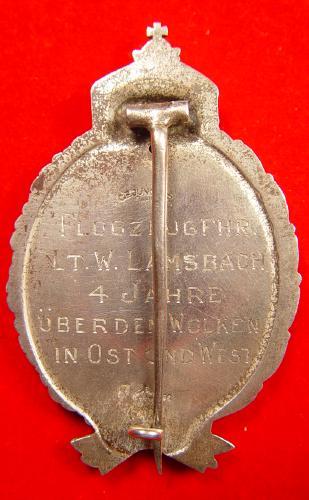
Reverse of crown well is
shallow and lacks proper shape. Both the Crescent Moon
and Imperial Crown silver marks together are not
documented on period badges. This badge appears to have
a silver-plating which is not consistent with its 800
silver markings. Fantasy engravings are common and
intended to distract the collector from obvious
problems. This badge measures from tip of cross to
bottom of ribbon ~ 72 mm. Width is 44 mm at widest point
across the middle. Weight is 29.38g. This badge, a
common fake, does not meet the baseline criteria
established for a period badge
Meybauer and Carl Poellath
Badges
Things do not
get any better with Carl Poellath Firm Bavarian badges.
To start, collectors and historians still have not been
able to resolve the very basic issue of the firm name of
Carl Poellath or Karl Pollath. Both C. Poellath and Karl
Pollath marks are found on original badges. Carl
Poellath has been found on original cases.
The Poellath badge baseline design accepted by
collectors for years, in my opinion, is now in question.
The number of Bavarian Air Service Pilots during WWI was
very small, so these badges are very rare, and the gross
overabundance of these badges on the collectors’ market
points to only one painful conclusion.
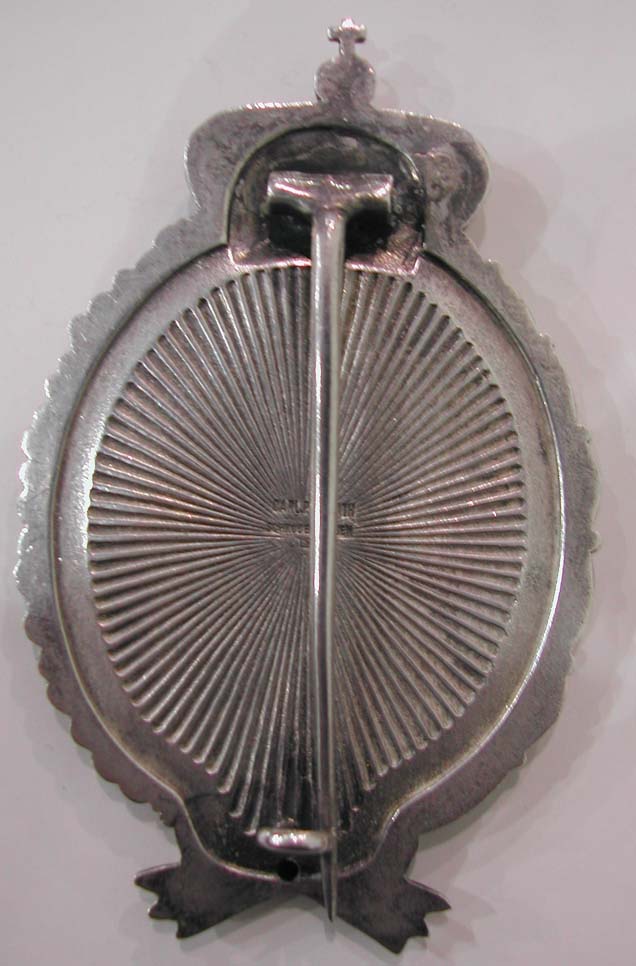
Bavarian pilots badge marked
Carl Pollath, Schrobenhausen. Marked Silber. Note the
half circle shaped crown well and T-pin style hinge with
a thin pin which is identical to that found on fake
Juncker and Meybauer badges. Length - 71 mm, Width - 45
mm. This half circle crown well design is in conflict
with the crown well design found on many Bavarian badges
in older German collections and museums. I caution
collectors that it is highly likely that these half
circle shaped crown well badges are in fact forgeries. I
do not accept these badges.
The Bavarian pilot’s badge design
currently accepted by collectors. Marked Carl Poellath,
Schrobenhausen. Also seen as Karl Pollath, according to
the firm early badges were marked as C. Poellath, then
Karl Pollath was used at some point during WWI and after
WWI until production ended during WWII. Both marks were
used indiscriminately by the firm. Bavarian badges are
not seen with the Prussian Crown and Moon silver
hallmarks. Note: spider web pattern to patina, which is
common on late war badges of lesser silver quality
(plated) and should be a red flag when seen on an 800
marked badge or higher. The stylized cutout cross is
typical of Bavarian badges and crown inserts are
sometimes cut out.
Period Poellath Gunner’s
badge. Marked Karl Pollath, Schrobenhausen, 800 on three
separate lines. 73mm – length, 45mm – Width, 22.0g. Note
the Poellath crown well style and pin.
Unmarked Bavarian Observer’s
badge made by Poellath, Schrobenhausen. Note the unique
shape of the crown well. ~ Length - 73 mm, Width - 45
mm, Weight – 23.9g. Reverse patterns are found in plain
and ray back style. Prongs on the reverse are found
horizontal and vertical. Note the pin style.
Period Meybauer Observer badge.
Meybauer badges are found with stylized crosses. There
is only the Meybauer crest on this badge. Correct
Meybauer pin style and hinge. Meybauer crown wells tend
to be shallower than Junckers and an almost oval shape.
Note Meybauer style ribbon. Enamel signals shield
attached with two bent prongs through the reverse.
Photo: Stogieman
Details should conform to the period
baseline examples presented. Cutout crown inserts are
not as common on Meybauer or Poellath badges. The
reverse of the crown or crown well area where the pin
attaches is semi-oval for
For Meybauer badges, details should conform to the
period baseline examples presented. Cutout crown inserts
are not common on Meybauer or Poellath badges. The
reverse of the crown or crown well area where the pin
attaches is semi-oval for Meybauer, and not as deep as
Juncker badges.
Pins should be the Meybauer coke bottle or flared style,
hinges block style, ribbon should be Meybauer design.
Only very early Meybauer badges of proper silver content
have been seen with Crescent Moon silver marks. These
badges are rare since many believe that Meybauer was
primarily a post WWI manufacturer of badges. Most
Meybauer badges are marked with the Meybauer crest only
or with silver content numbers.
Neither Meybauer nor Poellath are found with both the
Crescent Moon and Imperial Crown silver marks together.
The Poellath firm badges are found with Silber or 800
marks.
The determination of period Carl Poellath badges, in my
opinion, is now in dispute. After three years of
studying these rare badges in old German collections, to
include O Conner’s, and German Museums I have not found
a Poellath badge with a half circle crown. Only on one
occasion did I find one with a collector and he
immediately told me that is was a fake that arrived on
the scene in the 1980’s.
The fact that we find faked Juncker and Meybauer badges
with the half circle shaped crown well, as well as the
sheer quantity of this design on the market, sound an
alarm in my book. The C. Poellath vs. Karl Pollath or
Old German vs. New German, o with an umlaut = oe in the
firm name spelling variation is yet to be completely
resolved, but at present both markings are accepted. I
do not like Carl Poellath on a badge, but a case is OK.
The Carl Poellath firm ended badge production during
WWII, however the firm still exists today and is located
on Carl Poellath Str. in Schrobenhasen. In interviews,
they stated that the original tooling and die-sets are
long gone, and that they are no longer making these
badges. Local collectors have shown me Bavarian Pilot
badge stampings from an original die that was located
several years ago, but only the front was ever found.
Old stocks left over after WWII marked Karl Pollath were
known to be found into the 1960s. As pictured in this
article, Karl Pollath may be scratched out on these
badges in an attempt to hide their “secret source.” The
location of the original die-sets is unknown.
Many feel that recent forgeries of these and other
badges are originating from the USA, and not Germany.
The quality of the Eastern European forgeries, I know
them well from my work with Soviet badges, are
excellent. Be a very hard judge; look for old silver
qualities and authentic age in your analysis. Unmarked
badges, should still meet inspection criteria and
quality standards.
Fake Meybauer Badges
Meybauer marked pilot badge.
The problem is that is has a Juncker style ribbon vs. a
Meybauer ribbon. The two firms used very different
ribbon styles. You will see it on all of their original
badges. The badge is not 800 silver as marked; it is a
cheaper silver plate.
Meybauer marked Prussian
Army Commemorative Pilot badge that is commonly seen on
the market. The thin pin style is wrong for Meybauer,
and details are poor. These badges are not accepted as
period Meybauer.
Conclusions
This article is filled with many personal observations
and is by no means the final word on this subject.
In review, it is a fact that the Imperial Prussian Order
supports the use of the Imperial Crown and Crescent Moon
silver hallmarks. The failure to use the required silver
content marks by any firm prior to November of 1918
remains an enigma yet to be answered. It is believed
that it was an interpretation of paragraph 9 of the
Order that allowed firms to omit these marks on
jewelry-type items. Manufactures of larger silver items
seemed to be less flexible:
The most credible source of documentation to date has
come from a study of old attributed badges with a degree
of provenance, and reliable museum pieces. Many museums
collections have been compromised through theft and
replacement with fakes over the years so caution is
warranted with museum pieces. Any new evidence from a
verifiable collection or source is welcomed. The
combining of a doctored badge to an authentic flight log
or period case or insertion into an original grouping
does not establish a credible history, regardless of the
story.
I caution again, hallmarks alone are simply not a single
evaluation point for professionals in the antique silver
collecting community, nor should it be in this case.
Silver experts advise that many aspects should be
evaluated in judging originality of a piece. If you have
forgotten the feel and look of old silver, take a trip
to your grand mother’s house or local antique shop and
handle some old sterling silver. Observe the weight,
wear, hallmarks, patina, and warm almost blue glow of
sterling silver that has been used and polished over the
years.
I hope this will prompt more objective evidence to
surface. I have attempted to remain neutral on the
subject; I have no vested interest or hidden agenda.
Many dealers and collectors disagree with the opinions
or theories expressed in this article. I respect their
opinion and welcome any documentation that supports
alternative positions.
Good Hunting!
Robert Pandis
My thanks to: Peter Groch,
Don Chalif, Rick Versailles - “Stogieman,” Bob Gill,
Wolfe - Hardin, Gordon Williamson, David Beasley, Connie
McNally - Silver Magazine, Robert Bailey - NYU, Peter
Merta Klaus - German History Museum, AERONAUTICUM,
German Naval Airship and Aviation Museum, Ron Wolin,
Matthias Sladek, DEGUSSA Experts, Stephen Previtera,
Richard Mundhenk, LTC. Robert S. Pandis USAF (ret.),
Mark Hodge, Perry Young,William Baugher, and many
unnamed others for their help in this article. Special
thanks to the many works on Imperial German Aviation
Awards by Neal O’ Conner covering the period that were
used as reference in this article.
Contributors do not necessarily agree with my
conclusions.
© A. Schulze Ising, IX/05 |





